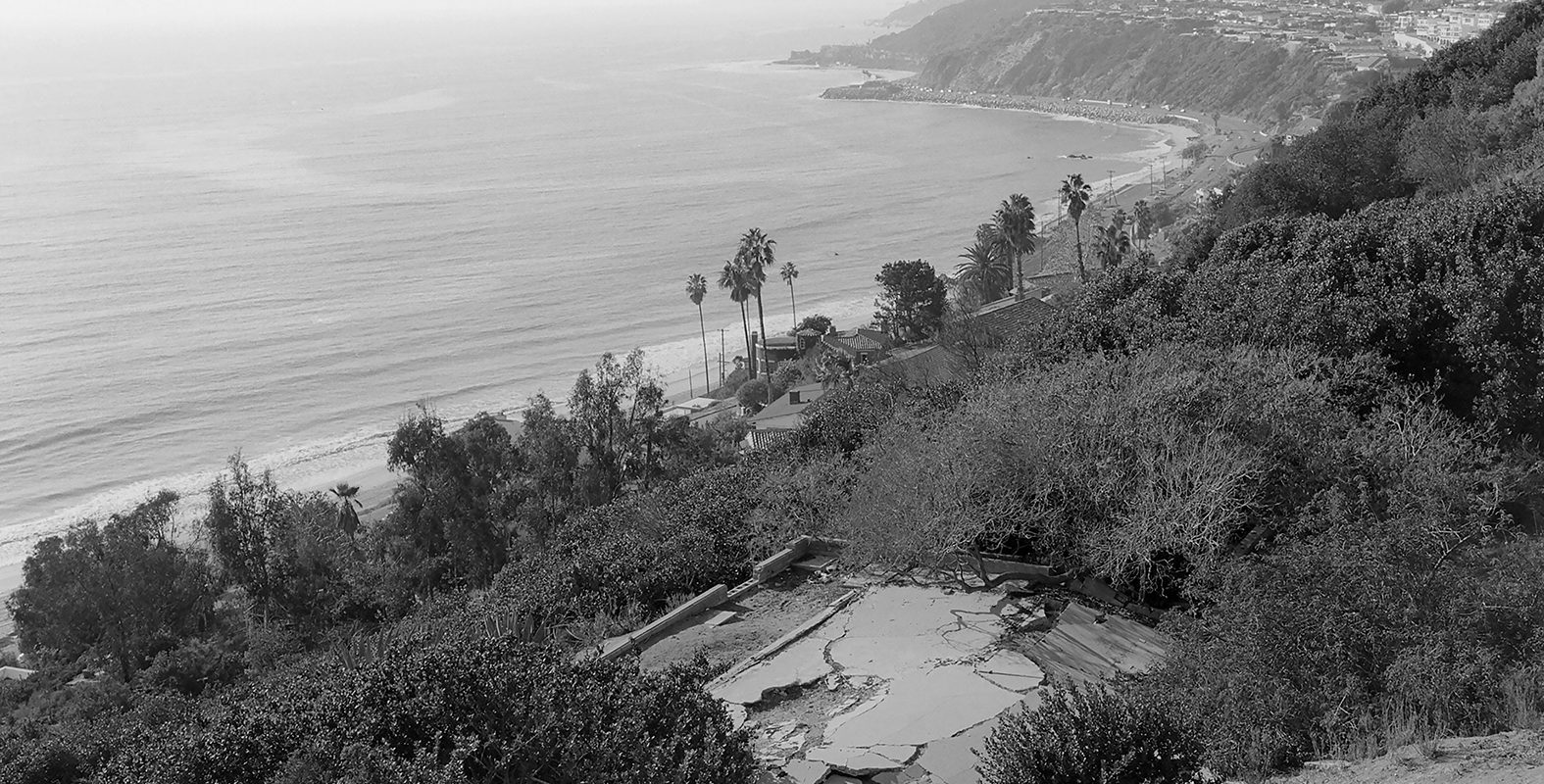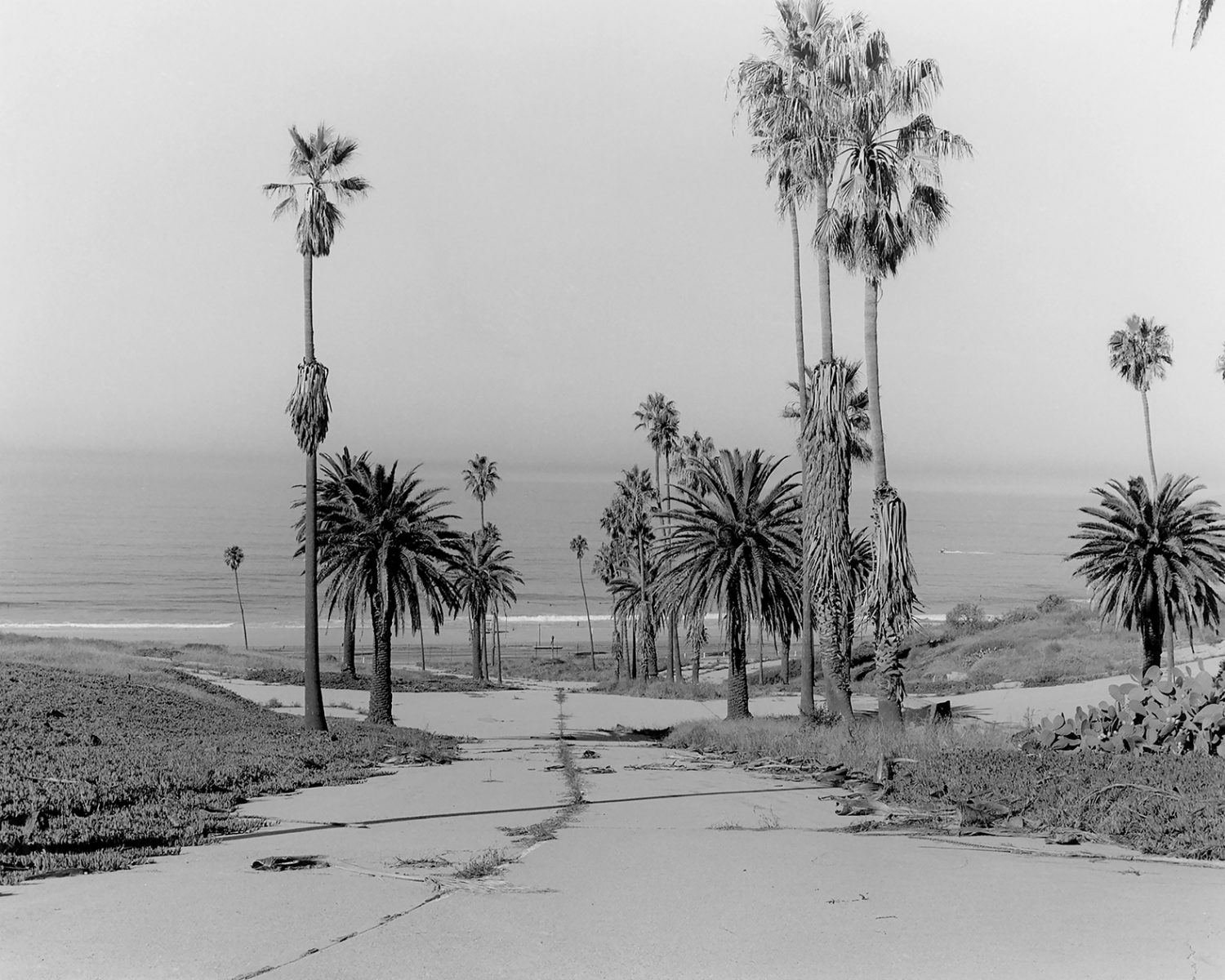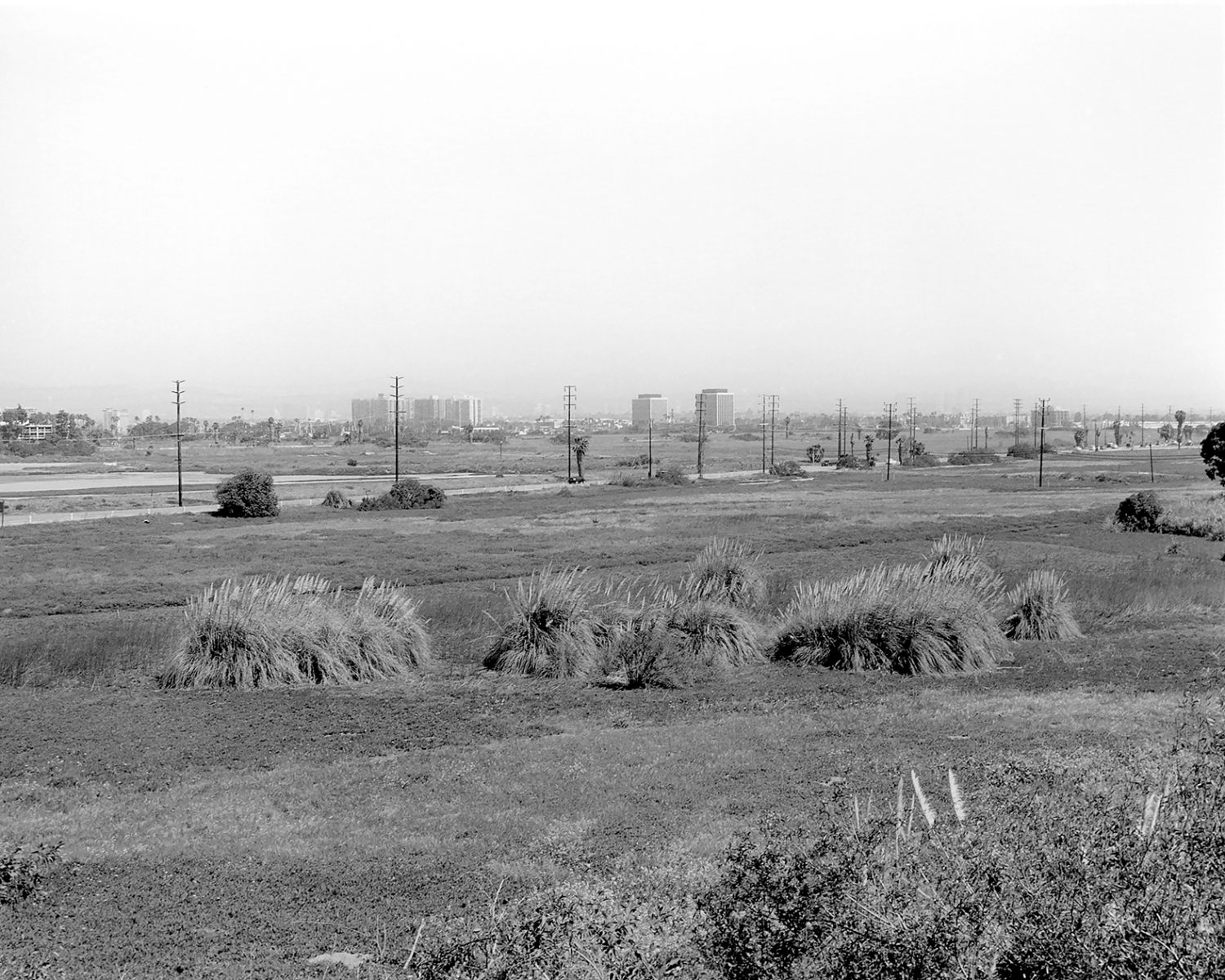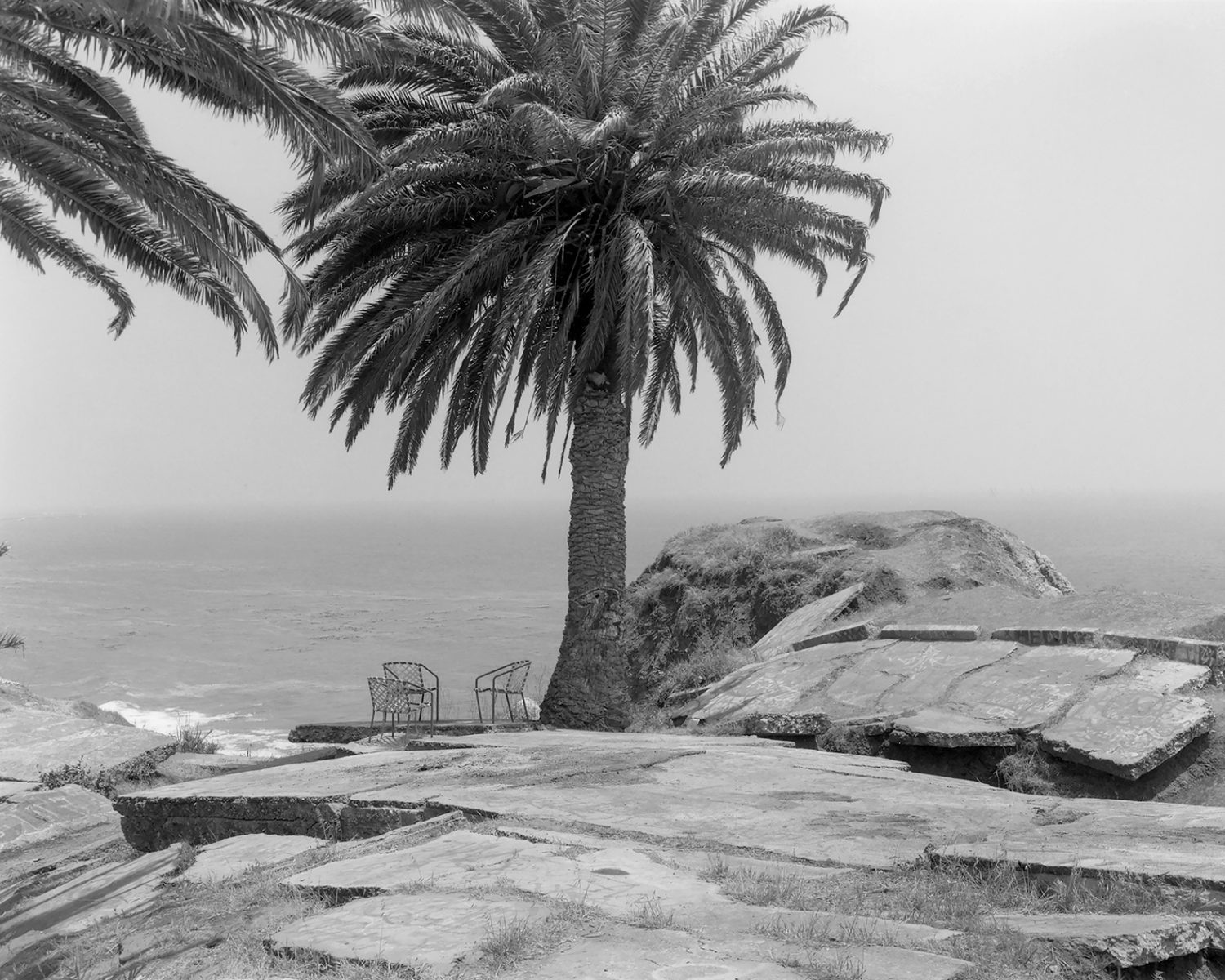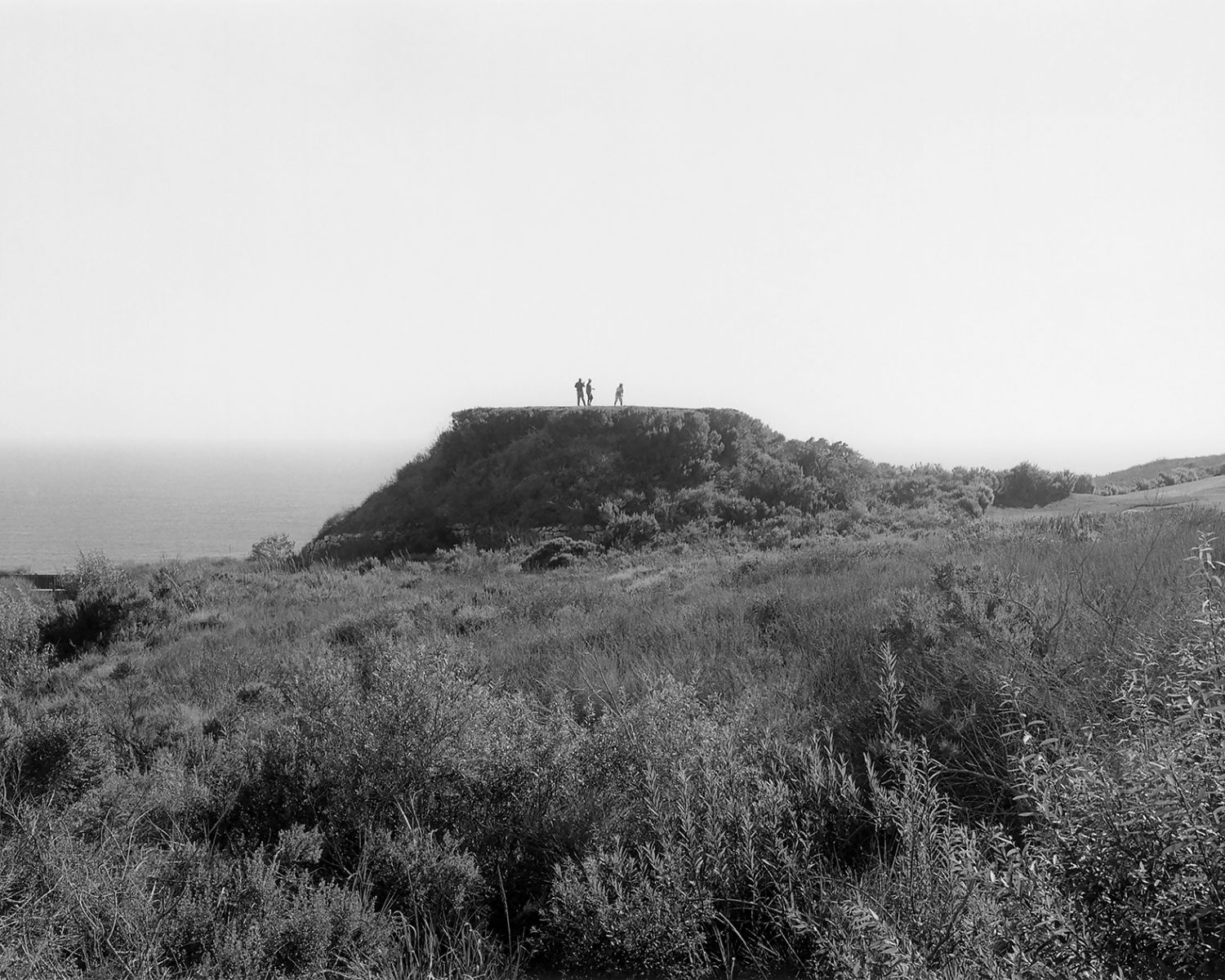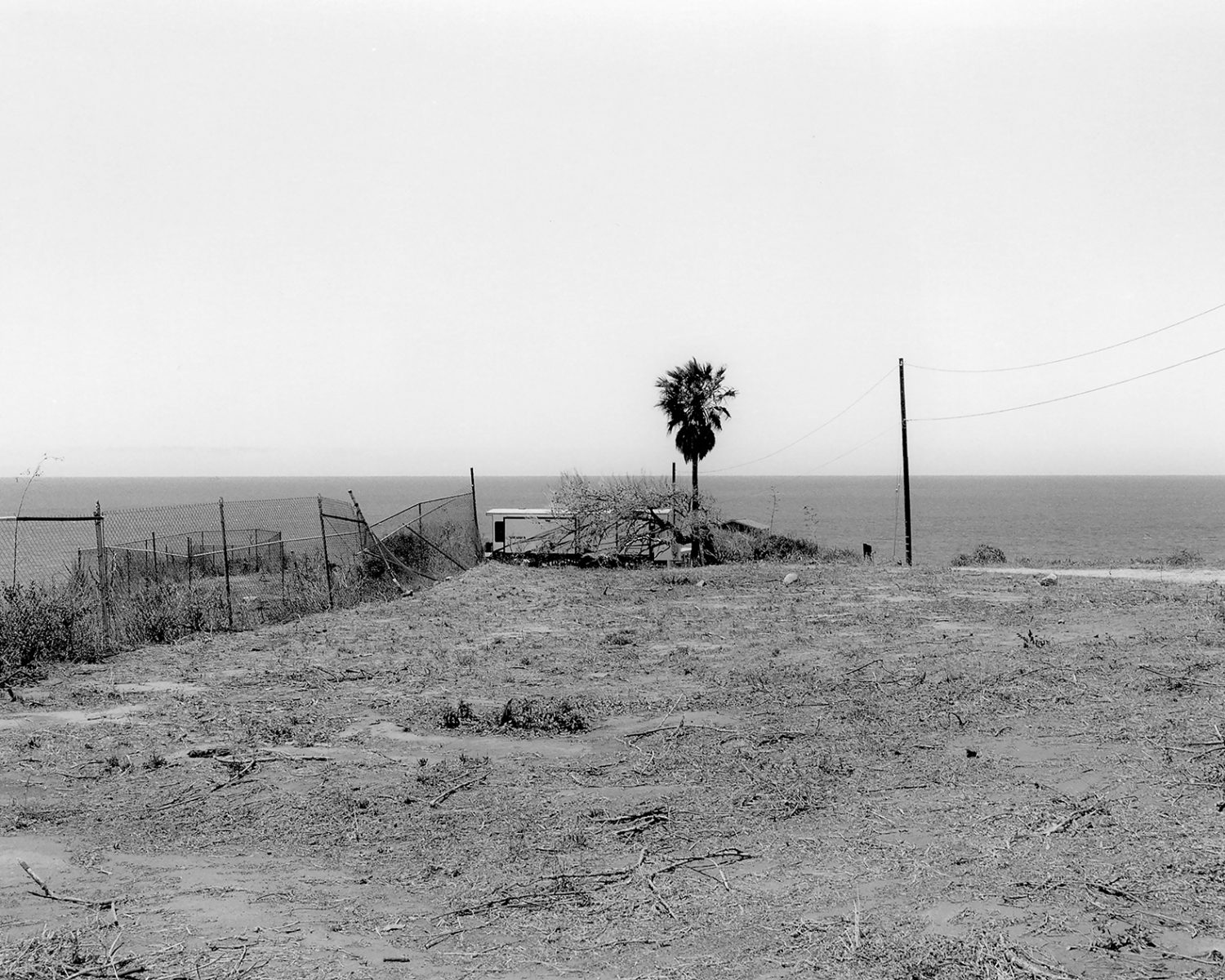Once on a departing flight from LAX, Mark Ruwedel glanced down from the height of his window seat and noticed a short tract of sand between the runway and the coastal highway. What stretched out below him was the El Segundo Dunes Preserve, the last remaining sand dunes in Los Angeles, still marked by the remnants of the neighbourhood of Surfridge, a seaside town of hundreds of homes demolished in the 1960s to make way for airport expansion. As the plane approached thirty thousand feet, the landscape appeared both fully undone and oddly legible, its pattern of disappearance rendered visible from above. It was this view that pointed toward the kinds of places central to Ruwedel’s The Western Edge (MACK, 2025), the less-travelled and fenced-off stretches of the coastal terrain he explored by car and on foot for over a decade, culminating in a photobook charting the shoreline of Southern California from Point Mugu to the Bolsa Chica Wetlands.
Ruwedel can be situated within a long line of artists and writers who have imagined Los Angeles on the precipice: a place where the frontier, and often the very dream of America, collapses at the shore. Carey McWilliams developed this vision of the region, which other critics later described as a kind of “frontier eschatology,” an image of the land refracted through apocalyptic premonition and extremist imagery.[1] Joan Didion’s non-fiction essay ‘Quiet Days in Malibu’ offers one of the clearest examples of this eschatological approach, set during the 1978 Agoura-Malibu firestorm, when fires consumed houses and horses alike. In these scenes, Didion argued, catastrophe revealed itself as the truest image of the city. Other examples also come to mind, from Bas Jan Ader, who walked from the Hollywood Hills to the Pacific, to Thomas Pynchon, who located a “luminous edge” in his gum-sandaled noir, Inherent Vice (2009).
The edge of California has always been a stage for bad endings, noir climaxes: cars run aground, houses topple into surf, and murders take place on ocean piers. “The meeting place of ocean and road,” noir historian Paul Skenazy writes, “confirms that there is no turning back. Maybe this is part of the lesson of cars in the California story: the faster one travels, the more one realizes that there is nowhere to go.”[2]
Ruwedel takes up this sand-and-asphalt melodrama. His photographs show freeways running aground, roadways terminating at cliff sides, signage half-buried or sliding into the ocean. Public beach parking lots are taken over by private beach houses, where fences and makeshift barriers mark divisions between those who are allowed access and those who are excluded. Palm trees stand like ceremonial guides to the ocean, only to lead toward sewage pipes thrusting out of the sand. Remnants of roads dangle from the sky, once grand trees lie parched and skeletal, and cracked foundations burst apart as if pushed from below.
The Western Edge is part of Ruwedel’s larger project, Los Angeles: Landscapes of Four Ecologies, which also includes the photobook Rivers Runs Through It (2023) and forthcoming volumes Mountains and Canyons and Haunted by the Desert. Made at intervals over the course of a decade, these images map out a long, sustained engagement with the region. Selections from all four series were exhibited at Gallery Luisotti (September 20 – January 4, 2025), offering a methodical survey of the city’s coasts, hills, rivers, and desert plains.
The project reads as a photographic rebuttal to Reyner Banham’s car-centric Architecture of Four Ecologies (1971). Following writers like Peter Plagens and Mike Davis who dismissed Banham’s account for its booster overtones and gloss, Ruwedel renders the city in a more unforgiving register, venturing into places and sites Banham neither considered nor cared about. Unlike the easily accessed drive-by vistas from the coast highway, many of the sites Ruwedel photographed were effectively fenced-off and off-limits to most residents and tourists, reachable only through volunteer programs — such as pulling invasive plants in the El Segundo Dunes — or by joining guided tours of areas like the Los Cerritos Wetlands or the Seal Beach Wildlife Refuge.
Within Ruwedel’s series, some photographs can feel unremarkable, as if they are simply records of a place at a given moment, useful as evidence in another context. Ruwedel often works in this forensic mode, whether as a kind of detective uncovering patterns in the landscape, or as a surveyor operating in a topographical register. All the while, both positions lean toward the sublime, as the seemingly factual image tilts into a different register altogether. That tilt is never stable–it is haunted by irony, even a touch of farce. In his images, the vastness of the coast is shadowed by human futility, as the impulse to build and live near the shore collides with the inevitable threat, or eventual destruction, of those structures by the elements. Regardless of whether the natural disaster has come, gone, or is yet to arrive, people will pull up deck chairs to enjoy the view.
There’s always the temptation to allegorize: to read each landslide as national decline, each buckled road as prophecy. And certainly the images invite it. Compositionally, Ruwedel’s photographs recall that mural Isle of California, painted by the Fine Arts Squad in 1972, a freeway cracked and crashing into the Pacific, a fantasy of imminent collapse that already feels like a documentary. Along this line of thought, Ruwedel’s images also bring to mind the landscapes imagined by the science-fiction writer J.G. Ballard, particularly in Hello America, where near-future America’s eastern seaboard is overtaken by shifting sands. Ballard’s landscapes are often defined by entropy, the gradual, inevitable dissolution of human order into natural forces. However, Ballard’s characters navigate these terrains not in panic or despair, but with acceptance. They inhabit the world as it disintegrates, adapting to its collapse, moving through sand dunes and ruins as if it were simply another condition of life.
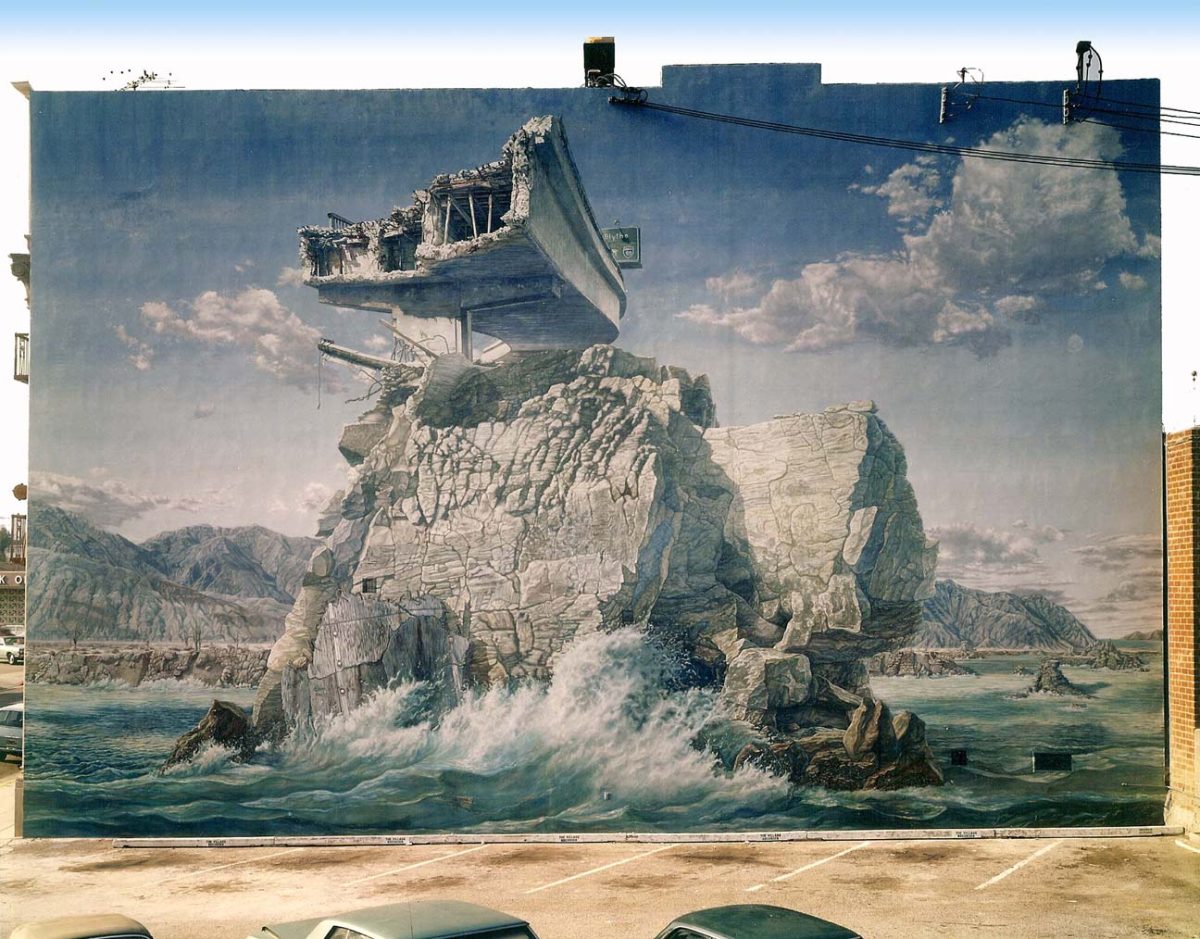
Los Angeles Fine Arts Squad (Victor Henderson, Terry Schoonhoven, and Jim Frazin), Isle of California (1972).
Unlike Ballard, Ruwedel doesn’t need to imagine the ruin, it is already there. In Pacific Palisades, landslides and earthquakes had left stairways and terraces leading nowhere. In San Pedro, the “Sunken City,” a neighbourhood that slid into the Pacific in 1929, remained as broken slabs decorated with graffiti. In Rolling Hills Estates, a gated enclave crumbled in slow motion into the canyon below in 2023. Even as Ruwedel was photographing these movements of land, storms, fires, and mudslides were already erasing stretches of the Pacific Coast Highway. By early 2025, the Santa Ana winds had spread catastrophic fires across Malibu and Pacific Palisades, devastating many of the sites he had previously photographed. The combined effects of this sequence contribute to what Duncan Forbes, in an essay on the photographer’s work, calls a “realist ecology.”
What is this “realist ecology”? Forbes does not define it explicitly, but what he may be pointing toward is the way these images register a kind of metabolic rift visited upon the landscape, a fracture in ecological and social relations, a tearing open of the exchange between human life and the environments that sustain it. In Ruwedel’s images, the very processes that support life appear eroded or undermined, sacrificed to production organized for profit rather than for ecological or social survival. The result is a landscape that has been ruined and overburdened, where what should replenish instead corrodes and collapses under the pressure of profit and real estate speculation. It is no accident, then, that Ruwedel includes a photograph of the Trump National Golf Club on the Palos Verdes Peninsula — one of the few images with people — showing them standing on a levelled-off hillside for a round of golf. Bracketed by photographs of coastal ruin and collapse, the image is framed by the reminder that this landscape, too, will not last.
What is revealing is that Ruwedel’s series of photographs of the coastal edge contrasts sharply with another photobook published in 2025: Ayda Gragossian’s North North South (Gost Books, 2025). Gragossian’s also takes Los Angeles as her focus, photographing not on the city’s edge, but on suburban exteriors, ivy-cloaked under-bridge overpasses, the façades of garages, trash-strewn back alleys, stairways with overgrown grasses leading nowhere but a demolished lot. Like Ruwedel, she photographs a city largely devoid of people. Both artists work in black and white, presenting an overwhelmingly unforgiving vision of Los Angeles. While Ruwedel emphasizes the ruin at the edge of the city, Gragossian photographs the architecture of everyday life dispersed across the social field. From the book’s description, we are told these are “overlooked spaces,” but the book’s arrangement makes the peripheral and overlooked feel central, as if the margin has expanded to structure the whole. Looking at both books in the summer of 2025, certain questions become apparent. What do we make of these two books on Los Angeles, both presented in black-and-white? Why adopt such a monochromatic and stark vision of the city? What do we make of this “realist ecology” in relation to Ruwedel’s and Gragossian’s work?
I don’t have the answer to these questions. But like most accounts of Los Angeles, maybe it has something to do with a more general feeling in America, a feeling that hangs over the city and emerges in the fracture of political life that these images keep circling back to. It is easy to read these images allegorically, to let the broken ground and unstable terrain stand in for the political disaster that is America. But maybe that line of thought goes too far. Photography doesn’t return to the abandoned lot, the hillside view, or fenced-off wetland only because they lend themselves to metaphor. It returns because these are places where people brush up against the limits of access, where the traces of habitation and neglect continue to shape everyday experience, where erosion, fire, and flood remind us that everything here sits under the constant threat of the natural world. The point isn’t allegory so much as awareness and attention: photography keeps returning to these spaces because they are a part of daily life and the city’s lived ecology, not because they stand in for something else.
[1] I take up this concept of “frontier eschatology” in my book, Lost Days, Endless Nights: Photography and Film from Los Angeles (MIT Press, 2025). See also: Kerwin Lee Klein, “Apocalypse Noir: Carey McWilliams and Posthistorical California.”
[2] Paul Skenazy, James M. Cain (New York: Frederick Ungar/Continuum, 1989), 21.
